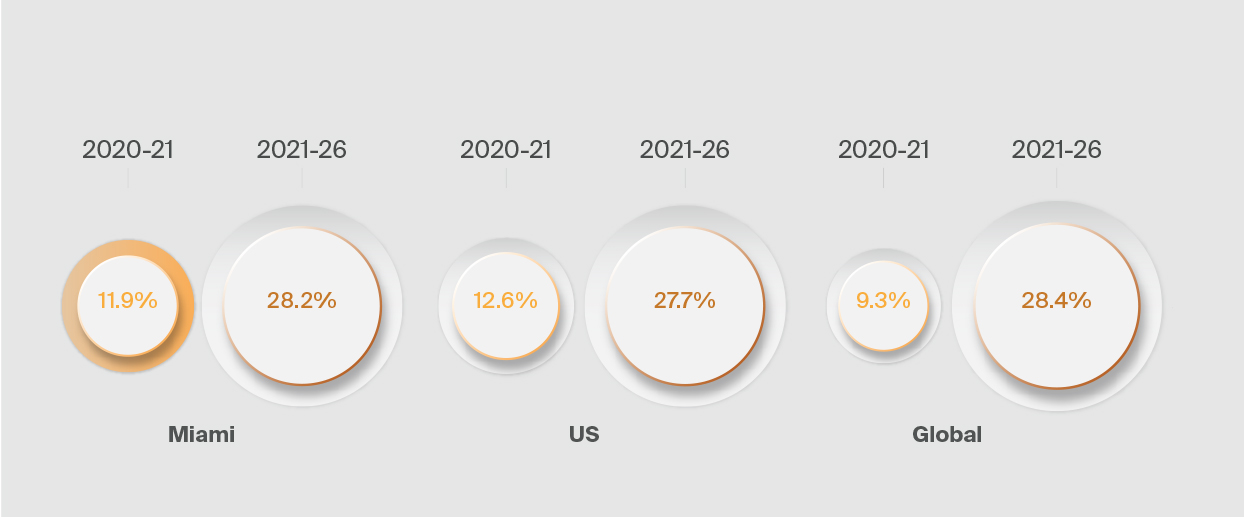Why all eyes are on Miami’s residential market
Miami’s luxury property market was one of the world’s top performers in 2021 and is expected to outperform in 2022.
4 minutes to read
Sales in Miami-Dade County increased 40% in 2021 year on- year but will demand wane as the pandemic shifts to the rear-view mirror or will price growth persist as the crisis has shone a spotlight on the city’s lifestyle?
Headwinds are also mounting, these include growing wealth inequality, tighter monetary policy as a result of rising inflation and the geopolitical crisis in Ukraine. More muted economic growth looks to be on the cards in 2022. Plus, we expect taxes and cooling measures to increase as policymakers try to curb house price growth and manage pandemic-induced deficits.
Below we highlight some of the latest trends.
10 things you need to know about the Miami market
1. Wealth is rising
Miami is home to 2,834 ultra-high-net-worth individuals, a figure that increased by 11.9% in 2021 and is forecast to rise by 28% over the next five years. Buoyed by a pandemic induced economic rebound, the appeal of coastal living and Florida’s low tax regime, the market is not only seeing homegrown wealth flourish, but it is attracting wealthy buyers from across the US and overseas.

2. Inequality is rising
“Wealth creation cannot continue in a vacuum” according to the Taxing Times article in The Wealth Report 2022. The pandemic has widened the wealth inequality gap. Policymakers are therefore paying closer attention to housing affordability. We expect taxes and cooling measures to strengthen in number and stringency in 2022 as governments look to redress the balance and plug their deficits.

3. Miami was home to the fourth strongest performing luxury property market in 2021
Registering an increase of 28.2%, Miami was one of the top performers in the 2021 edition of the Prime International Residential Index which benchmarks luxury residential prices across 100 of the world’s top markets.

Trends identified in 2020 including the race for space, the rise of co-primary living, the surge in hybrid working and the return of expats all became supercharged in 2021. Add to this strong wealth creation due to economic growth, amassed savings during successive lockdowns and buoyant equity markets and more wealth was channelled into real estate.
4. $3 million, the amount needed to access the top 1% of Miami’s housing market
To enter the rarefied 1% zone in Miami, a buyer would need $3 million, a fraction less than the equivalent entry point for Berlin but notably higher than the sum required in Cape Town, Mumbai and Sao Paulo. The values not only reflect market pricing but activity across the whole marketplace. With a higher volume of sales, we can expect to see lower price thresholds.

5. $1 million buys 77 square metres of prime property in Miami
Miami’s relative value remains a key draw for buyers, both domestic and international. Based on prime prices at the end of 2021, a million dollars in Miami buys 77 square metres more space than in cities such as Paris, Sydney, Geneva, London and Hong Kong.
6. Prime price growth in Miami will be almost double the global average in 2022
Prime prices in Miami are forecast to rise by 10% in 2022, outpacing the global average of 5.7%.
Although 10% represents strong growth, it will be a marked slowdown compared to 2021. However, last year was a special case as the wealthy reassessed their housing requirements on the back of the pandemic and the US economy surged.
Although the cost of finance is expected to increase as interest rates rise in 2022, the level of wealth accumulation in the past two years will continue to support demand in the city.
7. Risks are rising
From inflation to interest rates, and from geopolitical conflicts to wealth inequality, risks are mounting. Some 83% of US-based wealth advisors say their clients consider inflation and rising interest rates to be the biggest threats to rising wealth in the US according to The Wealth Report’s Attitudes Survey.*
8. Rising opportunities
Real estate and technological/digital adoption are considered two key areas of opportunity for US-based UHNWIs according to The Attitudes Survey. Some 94% of US wealth advisors surveyed considered real estate the biggest opportunity for their clients, significantly higher than the global average of 72%. ESG by comparison was considered marginally less of an opportunity in the US (44%) than it was globally (52%).

9. South Florida's super-prime market feels the pinch
Trophy homes in South Florida's other affluent neighbourhood, Palm Beach were amongst the country’s most in demand asset during the pandemic. Sales of luxury condos in West Palm Beach jumped 60% in the final quarter of 2021 compared with a year earlier according to Douglas Elliman/Miller Samuel.
However, listings are down 67% year-on-year and the supply of luxury condos for sale equates to around 1.9 months of stock. This underlines the extent to which a lack of inventory could influence sales volumes in 2022.
10. Miami, the 24th most popular global city for the wealthy
The City Wealth Index assesses where in the world the wealthy want to live, work and invest. Miami scores highly in all three key categories; wealth, investment and lifestyle. Cities bounced back in 2021 as their appeal as hubs for connectivity, culture and economic growth became clear, Miami was no different.